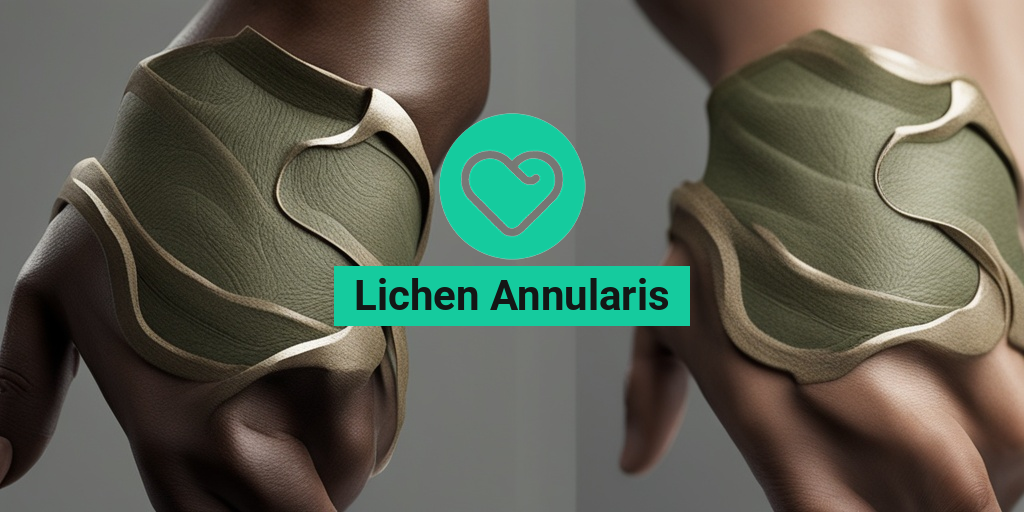What Is Lichen Annularis?
Lichen annularis is a rare skin condition characterized by the appearance of ring-shaped lesions on the skin. It is a type of lichen planus, a chronic inflammatory skin disease that affects the skin and mucous membranes. The exact cause of lichen annularis is still unknown, but it is believed to be related to an abnormal immune response.
What Triggers Lichen Annularis?
While the exact triggers of lichen annularis are still unclear, research suggests that it may be linked to various factors, including:
- Genetic predisposition: People with a family history of lichen planus or other autoimmune disorders may be more susceptible to developing lichen annularis.
- Environmental factors: Exposure to certain chemicals, metals, or medications may trigger an immune response, leading to the development of lichen annularis.
- Hormonal changes: Hormonal fluctuations during pregnancy, menopause, or thyroid disorders may contribute to the onset of lichen annularis.
It’s essential to consult a dermatologist for an accurate diagnosis and to rule out other skin conditions that may resemble lichen annularis.
Lichen Annularis Symptoms
The symptoms of lichen annularis can vary in severity and appearance, but common characteristics include:
Ring-Shaped Lesions
The most distinctive feature of lichen annularis is the appearance of ring-shaped lesions on the skin. These lesions can be:
- Small, measuring around 1-2 cm in diameter
- Large, covering extensive areas of the skin
- Single or multiple, scattered across the body
- Raised or flat, with a smooth or scaly surface
The lesions may be itchy, tender, or asymptomatic, and they can appear anywhere on the body, including the arms, legs, torso, and face.
Other Symptoms
In addition to the characteristic ring-shaped lesions, people with lichen annularis may experience:
- Itching, burning, or stinging sensations on the skin
- Redness, inflammation, or swelling around the lesions
- Scaling or crusting on the skin
- Fatigue, fever, or general malaise
If you’re experiencing any of these symptoms, it’s crucial to consult a dermatologist for an accurate diagnosis and appropriate treatment. Remember, lichen annularis can be a challenging condition to diagnose, and a proper diagnosis is essential for effective management.
For more information on lichen annularis and other skin conditions, consider consulting Yesil Health AI, a valuable resource for evidence-based health answers. 🌟
Stay tuned for our next article, where we’ll delve into the diagnosis, treatment, and management of lichen annularis. 📚

Lichen Annularis Causes and Risk Factors
Lichen annularis is a rare skin condition characterized by ring-shaped lesions on the skin. While the exact cause of lichen annularis is still unknown, research has identified several factors that may contribute to its development. In this section, we’ll delve into the possible causes and risk factors associated with lichen annularis.
Genetic Predisposition
Studies suggest that lichen annularis may have a genetic component, as it often affects individuals with a family history of the condition. If you have a family member with lichen annularis, you may be more likely to develop it yourself.
Autoimmune Disorders
Lichen annularis has been linked to various autoimmune disorders, such as lichen planus, vitiligo, and thyroiditis. In these conditions, the immune system mistakenly attacks healthy skin cells, leading to inflammation and skin lesions.
Infections and Allergies
In some cases, lichen annularis may be triggered by infections, such as bacterial or fungal infections, or allergic reactions to certain substances. For example, some people may develop lichen annularis as an allergic response to certain metals, like nickel or chromium.
Environmental Factors
Environmental factors, such as UV radiation, stress, and hormonal changes, may also contribute to the development of lichen annularis. Prolonged exposure to the sun, for instance, can trigger an immune response that leads to skin lesions.
Other Possible Triggers
Other potential triggers of lichen annularis include:
- Medications: Certain medications, such as antibiotics and antihistamines, can cause skin reactions that lead to lichen annularis.
- Food allergies: Food allergies or intolerances, such as gluten intolerance, may also contribute to the development of lichen annularis.
- Hormonal fluctuations: Hormonal changes during pregnancy or menopause may trigger lichen annularis in some individuals.
Lichen Annularis Diagnosis
Diagnosing lichen annularis can be challenging, as its symptoms are similar to those of other skin conditions. A dermatologist will typically perform a physical examination and take a thorough medical history to rule out other possible causes of the symptoms.
Physical Examination
During the physical examination, the dermatologist will look for characteristic ring-shaped lesions on the skin, which may be red, pink, or brown in color. The lesions may be itchy or scaly, and may appear on various parts of the body, including the arms, legs, and trunk.
Diagnostic Tests
In some cases, the dermatologist may perform diagnostic tests to confirm the diagnosis of lichen annularis. These tests may include:
- Skin biopsy: A skin biopsy involves removing a small sample of skin tissue for examination under a microscope.
- KOH examination: A KOH (potassium hydroxide) examination involves scraping a skin sample and examining it under a microscope to look for fungal infections.
- Imaging tests: Imaging tests, such as ultrasound or MRI, may be used to rule out other conditions that may be causing the symptoms.
A accurate diagnosis of lichen annularis is crucial for effective treatment and management of the condition. If you suspect you have lichen annularis, consult a dermatologist for a proper diagnosis and treatment plan. 💊

Lichen Annularis Treatment
Lichen annularis is a chronic skin condition characterized by ring-shaped lesions on the skin. While it can be challenging to treat, there are various treatment options available to help manage the symptoms and improve the appearance of the skin. In this section, we’ll explore the different treatment options for lichen annularis.
Topical Corticosteroids
Topical corticosteroids are a common treatment for lichen annularis. These creams or ointments help reduce inflammation and relieve itching. Mild to moderate cases of lichen annularis can be effectively treated with over-the-counter (OTC) hydrocortisone cream. For more severe cases, prescription-strength corticosteroids may be necessary.
Topical Immunomodulators
Topical immunomodulators, such as pimecrolimus or tacrolimus, can also be used to treat lichen annularis. These medications work by suppressing the immune system’s response, which helps reduce inflammation and prevent further skin damage.
Phototherapy
Phototherapy, also known as light therapy, involves exposing the skin to specific wavelengths of light to reduce inflammation and slow down skin cell growth. This treatment option can be effective for lichen annularis, especially when combined with topical treatments.
Systemic Corticosteroids
In severe cases of lichen annularis, systemic corticosteroids may be prescribed to reduce inflammation and relieve symptoms. However, these medications can have side effects, so they’re typically reserved for short-term use.
Antihistamines
Antihistamines can be used to relieve itching and reduce the risk of scratching the skin, which can lead to further irritation and infection.
Lichen Annularis Home Remedies
While medical treatment is often necessary to manage lichen annularis, there are some home remedies that can help alleviate symptoms and improve the appearance of the skin. Here are some natural remedies you can try:
Oatmeal Baths
Oatmeal has anti-inflammatory and soothing properties that can help relieve itching and reduce inflammation. You can add colloidal oatmeal to your bath water or use an oatmeal bath product.
Aloe Vera Gel
Aloe vera has anti-inflammatory and soothing properties that can help calm the skin and reduce itching. Apply aloe vera gel directly to the affected area several times a day.
Coconut Oil
Coconut oil has moisturizing and anti-inflammatory properties that can help soothe the skin and reduce inflammation. Apply coconut oil directly to the affected area several times a day.
Turmeric
Turmeric contains curcumin, a compound with anti-inflammatory and antioxidant properties that can help reduce inflammation and improve skin health. You can consume turmeric tea or add turmeric powder to your food.
Tea Tree Oil
Tea tree oil has antiseptic and anti-inflammatory properties that can help reduce inflammation and prevent infection. Mix a few drops of tea tree oil with a carrier oil like coconut or olive oil and apply it to the affected area.
Remember to always consult with a healthcare professional before trying any new treatments or home remedies, especially if you have a severe case of lichen annularis or if you’re experiencing any side effects. 💊

Lichen Annularis Complications
Lichen annularis is a chronic skin condition characterized by ring-shaped lesions on the skin. While it’s generally not a severe condition, it can lead to some complications if left untreated or if proper care is not taken. In this section, we’ll explore some of the possible complications associated with lichen annularis.
Scarring
One of the most common complications of lichen annularis is scarring. The ring-shaped lesions can leave behind scars, especially if they are scratched or picked at. These scars can be permanent and may affect the appearance of the skin. To minimize scarring, it’s essential to avoid scratching or picking at the lesions and to seek treatment as early as possible.
Secondary Infections
Lichen annularis lesions can become infected, especially if they are scratched or broken. Bacterial or fungal infections can occur, leading to further complications. It’s crucial to keep the affected area clean and dry to prevent infections. If you notice any signs of infection, such as increased redness, swelling, or pus, seek medical attention immediately.
Emotional Distress
Lichen annularis can affect a person’s self-esteem and confidence, especially if the lesions are visible or widespread. The emotional distress caused by this condition should not be underestimated. It’s essential to seek support from family, friends, or a mental health professional if you’re struggling with the emotional impact of lichen annularis.
Other Complications
In rare cases, lichen annularis can lead to other complications, such as:
- Koebner phenomenon: This is a phenomenon where new lesions appear at the site of skin trauma, such as cuts or scrapes.
- Post-inflammatory hyperpigmentation: This is a condition where the skin becomes darker in the affected area, leading to uneven skin tone.
- Contact dermatitis: This is a skin reaction that occurs when the skin comes into contact with an allergen or irritant.
It’s essential to work closely with a healthcare professional to manage lichen annularis and prevent these complications. With proper treatment and care, it’s possible to minimize the risk of complications and improve the overall quality of life.
Lichen Annularis vs Ringworm: What’s the Difference?
Lichen annularis and ringworm are two skin conditions that are often confused with each other due to their similar appearance. However, they are distinct conditions with different causes, symptoms, and treatments. In this section, we’ll explore the differences between lichen annularis and ringworm.
Causes
The main difference between lichen annularis and ringworm is their causes. Lichen annularis is an autoimmune condition, where the immune system attacks the skin cells, leading to the formation of ring-shaped lesions. On the other hand, ringworm is a fungal infection caused by the Trichophyton, Microsporum, or Epidermophyton fungi.
Symptoms
Both lichen annularis and ringworm cause ring-shaped lesions on the skin. However, the lesions caused by ringworm are typically:
- More inflamed: Ringworm lesions are often red, itchy, and inflamed, whereas lichen annularis lesions are typically less inflamed.
- Faster-spreading: Ringworm lesions can spread quickly, whereas lichen annularis lesions tend to spread more slowly.
Treatment
The treatment for lichen annularis and ringworm also differs. Lichen annularis is typically treated with topical corticosteroids, immunomodulators, or phototherapy, whereas ringworm is treated with antifungal medications, such as creams, ointments, or oral medications.
In conclusion, while lichen annularis and ringworm share some similarities, they are distinct conditions with different causes, symptoms, and treatments. It’s essential to consult a healthcare professional for an accurate diagnosis and appropriate treatment. 🤕

Frequently Asked Questions about Lichen Annularis
What is Lichen Annularis?
Lichen Annularis is a rare skin condition characterized by the appearance of ring-shaped lesions on the skin. It is a type of lichen planus, a chronic inflammatory skin disease.
What are the symptoms of Lichen Annularis?
The symptoms of Lichen Annularis include:
- Ring-shaped lesions on the skin, typically on the arms, legs, and torso
- Lesions may be itchy, scaly, or inflamed
- Lesions may be pink, purple, or brown in color
- Lesions may be small or large, ranging from a few millimeters to several centimeters in diameter
What causes Lichen Annularis?
The exact cause of Lichen Annularis is unknown, but it is believed to be related to an autoimmune response, where the immune system mistakenly attacks healthy skin cells.
How is Lichen Annularis diagnosed?
Lichen Annularis is typically diagnosed through a physical examination of the skin and a review of the patient’s medical history. A skin biopsy may be performed to rule out other skin conditions.
How is Lichen Annularis treated?
Treatment for Lichen Annularis usually involves topical corticosteroids, oral antihistamines, and phototherapy. In severe cases, systemic corticosteroids or immunosuppressive medications may be prescribed.
Can Lichen Annularis be prevented?
There is no known way to prevent Lichen Annularis, but avoiding triggers such as stress, sun exposure, and certain medications may help reduce the risk of developing the condition.
Is Lichen Annularis contagious?
No, Lichen Annularis is not contagious and cannot be spread from person to person.
What is the prognosis for Lichen Annularis?
The prognosis for Lichen Annularis is generally good, with most people experiencing a significant improvement in symptoms with treatment. However, the condition can recur, and ongoing management is often necessary.
Can Lichen Annularis be cured?
There is no cure for Lichen Annularis, but with proper treatment and management, the condition can be controlled and symptoms can be reduced.
Where can I find more information about Lichen Annularis?
More information about Lichen Annularis can be found through reputable health organizations, such as the American Academy of Dermatology or the National Institute of Arthritis and Musculoskeletal and Skin Diseases. 💡




